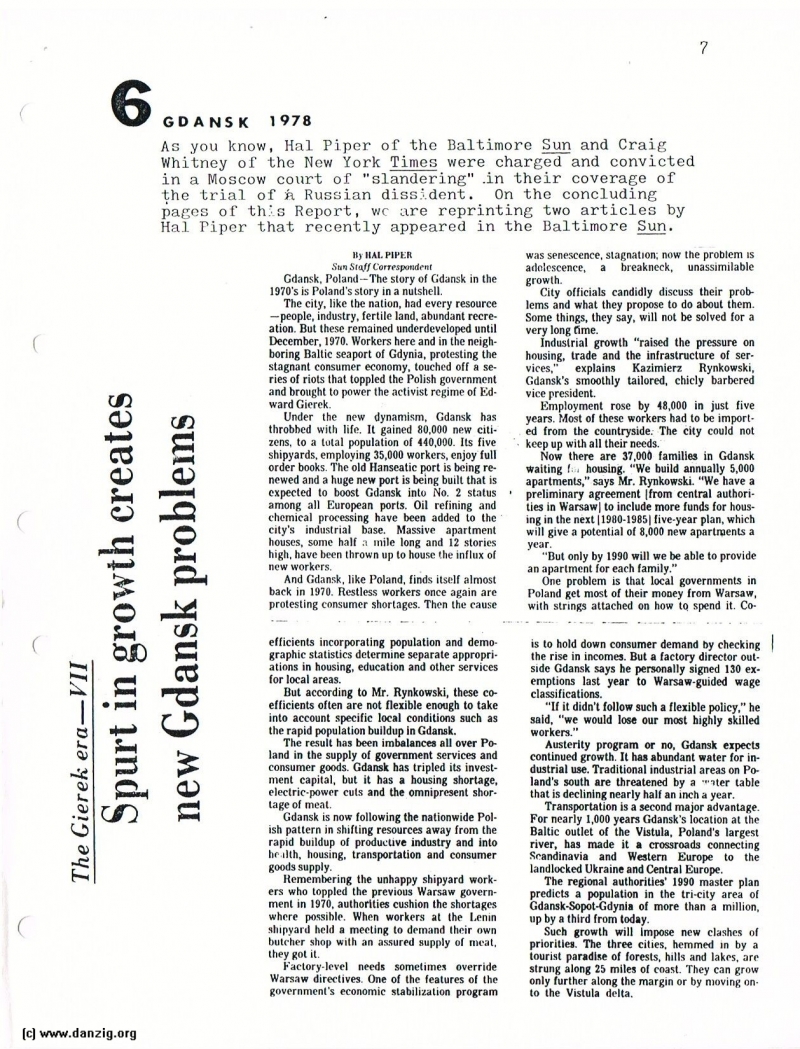
GDANSK 1978
As you know, Hal Piper of the Baltimore Sun and Craig Whitney of the New York Times were charged and convicted in a Moscow court of “slandering” .in their coverage of the trial of h Russian dissident. On the concluding pages of this Report, we are reprinting two articles by Hal Piper that recently appeared in the Baltimore Sun.
By Hal PIPER
Sun Staff Correspondent
Gdansk, Poland—The story of Gdansk in the 1970’s is Poland’s story in a nutshell.
The city, like the nation, had every resource —people, industry, fertile land, abundant recreation. But these remained underdeveloped until December, 1970. Workers here and in the neigh boring Baltic seaport of Gdynia, protesting the stagnant consumer economy, touched off a series of riots that toppled the Polish government and brought to power the activist regime of Edward Gicrek.
Under the new dynamism, Gdansk has throbbed with life. It gained 80,000 new citizens, to a total population of 440,000. Its five shipyards, employing 35,000 workers, enjoy full order books. The old Hanseatic port is being renewed and a huge new port is being built that is expected to boost Gdansk into No. 2 status among all European ports. Oil refining and chemical processing have been added to the city’s industrial base. Massive apartment houses, some half a mile long and 12 stories high, have been thrown up to house the influx of new workers.
And Gdansk, like Poland, finds itself almost back in 1970. Restless workers once again are protesting consumer shortages. Then the cause efficients incorporating population and demographic statistics determine separate appropriations in housing, education and other services for local areas.
But according to Mr. Rynkowski, these coefficients often are not flexible enough to take into account specific local conditions such as the rapid population buildup in Gdansk.
The result has been imbalances all over Poland in the supply of government services and consumer goods. Gdansk has tripled its investment capital, but it has a housing shortage, electric-power cuts and the omnipresent shortage of meat.
Gdansk is now following the nationwide Polish pattern in shifting resources away from the rapid buildup of productive industry and into health, housing, transportation and consumer goods supply.
Remembering the unhappy shipyard workers who toppled the previous Warsaw government in 1970, authorities cushion the shortages where possible. When workers at the Lenin shipyard held a meeting to demand their own buttler shop with an assured supply of meat, they got it.
Factory-level needs sometimes override Warsaw directives. One of the features of the government’s economic stabilization program was senescence, stagnation; now the problem is coalescence, a breakneck, unassailable growth.
City officials candidly discuss their problems and what they propose to do about them. Some things, they say, will not be solved for a very long time.
Industrial growth “raised the pressure on housing, trade and the infrastructure of services,” explains Kazimierz Rynkowski, Gdansk’s smoothly tailored, chicly barbered vice president.
Employment rose by 48,000 in just five years. Most of these workers had to be imported from the countryside. The city could not keep up with all their needs.
Now there are 37,000 families in Gdansk waiting f. housing. “We build annually 5,000 apartments,” says Mr. Rynkowski. “We have a preliminary agreement from central authorities in Warsawj to include more funds for housing in the next 1980-1985 five-year plan, which will give a potential of 8,000 new apartments a year.
“But only by 1990 will we be able to provide an apartment for each family,”
One problem is that local governments in Poland get most of their money from Warsaw, with strings attached on how to spend it. co is to hold down consumer demand by checking the rise in incomes. But a factory director outside Gdansk says he personally signed 130 exemptions last year to Warsaw-guided wage classifications.
“If it didn’t follow such a flexible policy,” he said, “we would lose our most highly skilled workers.”
Austerity program or no, Gdansk expects continued growth. It has abundant water for industrial use. Traditional industrial areas on Poland’s south are threatened by a -“tertable that is declining nearly half an inch a year.
Transportation is a second major advantage. For nearly 1,000 years Gdansk’s location at the Baltic outlet of the Vístula, Poland’s largest river, has made it a crossroads connecting Scandinavia and Western Europe to the landlocked Ukraine and Central Europe.
The regional authorities’ 1990 master plan predicts a population in the tn-city area of Gdansk-Sopot-Gdynla of more than a million, lip by a third from today.
Such growth will Impose new clashes of priorities. The three cities, hemmed in by a tourist paradise of forests, hills and lakes, are strung along 25 miles of coast. They can grow only further along the margin or by moving on to the Vistula delta,
Danzig Report Nr. 19 – May - June - July - 1978, Page 7.
Hits: 1819
Added: 06/06/2015
Copyright: 2024 Danzig.org

